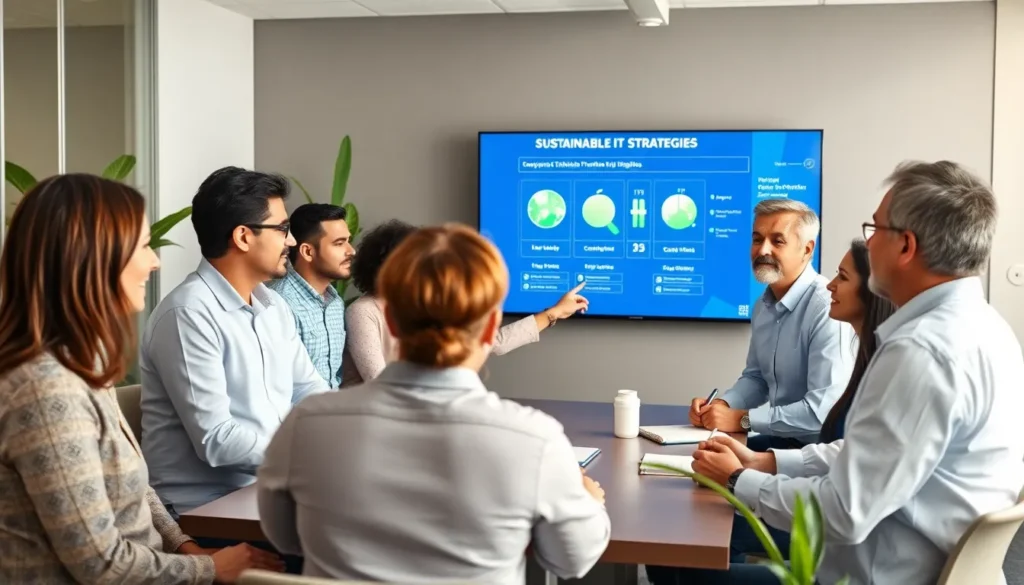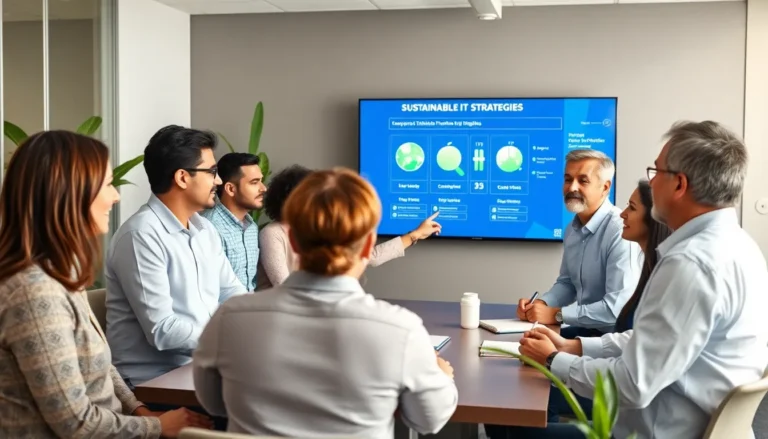Table of Contents
ToggleIn a world where tech can feel like a relentless energy monster, sustainable IT is the superhero we didn’t know we needed. Technology leaders are at the forefront of this eco-revolution, tasked with transforming their organizations into eco-friendly powerhouses. But how do they balance innovation with sustainability without sacrificing performance? Enter the sustainable IT playbook—your trusty guide to navigating this green landscape.
Understanding Sustainable IT
Sustainable IT addresses the environmental impact caused by technology. Technology leaders play a key role in integrating eco-friendly practices, striking a balance between innovation and environmental responsibility.
Importance of Sustainability in Technology
Sustainability in technology is vital for reducing carbon footprints. Organizations face increasing pressure to enhance energy efficiency, as data shows that IT accounts for approximately 2% of global greenhouse gas emissions. Adopting sustainable practices can lead to cost savings and improved brand perception. Stakeholders increasingly favor companies that prioritize eco-friendly initiatives. Focusing on sustainability strengthens competitiveness in the technology sector, where environmentally conscious consumers drive demand for greener solutions.
Key Principles of Sustainable IT
Key principles guide organizations toward sustainable IT practices. Energy efficiency serves as a primary goal, leading to decreased consumption and lower operating costs. Utilizing renewable energy sources, such as solar or wind power, further supports sustainability efforts. Efficient resource management minimizes waste, ensuring materials are reused or recycled. Design approaches emphasize sustainability, influencing hardware selection and product life cycles. Transparency and accountability enhance communication regarding sustainability goals, fostering trust among stakeholders.
Creating a Sustainable IT Strategy

A sustainable IT strategy focuses on minimizing environmental impact while enhancing operational efficiency. Engaging technology leaders in this process ensures accountability and encourages innovation.
Assessing Current IT Practices
Evaluating current IT practices serves as the foundation for a sustainable strategy. Organizations must analyze energy consumption across data centers and office environments. Identifying areas of inefficiency highlights opportunities for improvement. This assessment should include hardware utilization, software efficiency, and waste management practices. Tracking metrics helps establish a baseline for future sustainability efforts. Consequently, organizations can prioritize action based on their impact assessments.
Setting Sustainability Goals
Establishing clear and measurable sustainability goals drives the strategic direction of IT initiatives. Technology leaders should align these goals with organizational values and industry benchmarks. Setting ambitious yet achievable targets for energy reduction enhances motivation among teams. Options may include increasing the use of renewable energy by specific percentages within defined timelines. Incorporating feedback and adjusting goals empowers continuous improvement. Tracking progress ensures stakeholders remain engaged while fostering a culture of sustainability within the organization.
Implementing Sustainable Practices
Implementing sustainable practices requires a structured approach from technology leaders. Prioritizing energy efficiency and eco-friendly software development dramatically reduces environmental impacts and enhances overall business performance.
Energy Efficiency in Data Centers
Energy efficiency in data centers represents a critical area for sustainable IT. Implementing advanced cooling techniques significantly reduces energy consumption. Utilizing virtualization strategies optimizes server utilization, cutting down on redundant hardware. Employing renewable energy sources, such as solar or wind, further enhances sustainability. Regularly monitoring energy usage helps identify patterns and inefficiencies, allowing for targeted improvements. Leaders should adopt environmental standards like ISO 50001 to guide energy management practices effectively.
Eco-Friendly Software Development
Eco-friendly software development focuses on minimizing resource consumption and improving software efficiency. Writing clean, efficient code reduces the demand on processing power and energy. Employing methodologies such as Agile and DevOps encourages iterative processes that minimize waste. Prioritizing cloud solutions lowers hardware dependence and enhances scalability. Utilizing data analytics can help identify inefficient code or features, enabling necessary adjustments. Integrating sustainability assessments into the software development lifecycle ensures eco-friendliness becomes ingrained in the organization’s culture.
Measuring and Reporting Progress
Tracking sustainability efforts is essential for technology leaders. Firms must measure their impact to ensure ongoing improvement and accountability.
Key Performance Indicators (KPIs) for Sustainability
Technology leaders should establish precise KPIs to monitor sustainability initiatives. Energy consumption metrics reveal how efficiently technology resources are utilized. Carbon footprint assessments quantify greenhouse gas emissions associated with IT operations. Waste reduction percentages gauge the effectiveness of recycling and resource management practices. Stakeholder engagement metrics can also highlight involvement and support for sustainability goals. Aligning these KPIs with industry benchmarks provides context for evaluating progress and enhances transparency.
Tools and Frameworks for Reporting
Numerous tools exist to support sustainable IT reporting. Software solutions like Carbon Footprint Calculator and EnergyStar Portfolio Manager help organizations track energy use and emissions. Frameworks, such as the Global Reporting Initiative (GRI), provide structured guidelines for sustainability reporting. Industry standards, including the ISO 14001, facilitate environmental management system implementation. Using these resources aids technology leaders in communicating sustainability progress to stakeholders. Regular updates on metrics and initiatives foster a culture of accountability and commitment within the organization.
Engaging Stakeholders
Engaging stakeholders shapes a successful sustainable IT strategy. Technology leaders foster collaboration among teams, enhancing commitment to sustainability goals.
Building a Culture of Sustainability
Creating a culture of sustainability starts with leadership. Technology leaders set expectations, encourage open communication, and recognize contributions to sustainability efforts. Organizations benefit from training programs that raise awareness about sustainability practices. Regularly sharing successes and learnings strengthens the shared commitment, ensuring every team member understands their role in achieving sustainability. Fostering a culture where innovation aligns with sustainable values inspires continuous improvement and motivates employees to prioritize eco-friendly choices in their work.
Collaborating with Vendors and Partners
Building partnerships with vendors enhances sustainability initiatives. Collaborating on shared goals leads to better resource management and eco-friendly practices. Technology leaders prioritize selecting partners committed to sustainable practices, ensuring alignment with their organization’s objectives. Regular communication and joint projects strengthen these relationships, providing opportunities to innovate together. Conducting sustainability assessments on vendor practices allows organizations to make informed decisions. By engaging multiple stakeholders, technology leaders amplify their impact, creating a collective movement toward a more sustainable technology landscape.
Embracing sustainable IT is no longer optional for technology leaders; it’s a necessity. By integrating eco-friendly practices into their strategies, they can drive meaningful change that benefits both the environment and their organizations. This transformation requires a commitment to energy efficiency, resource management, and collaboration with stakeholders.
As technology continues to evolve, leaders must adapt and innovate to meet sustainability goals. By leveraging the principles outlined in the sustainable IT playbook, they can create a culture of accountability and transparency. The journey toward sustainability in IT not only enhances brand reputation but also positions organizations as responsible stewards of the planet. The time to act is now.







